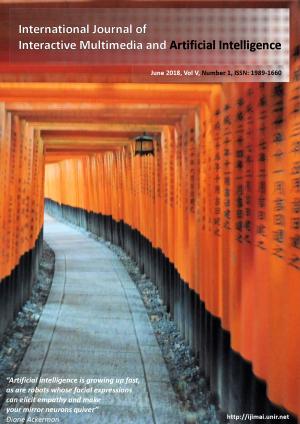- Year: 2018
- Vol: 5
- Number: 1
The International Journal of Interactive Multimedia and Artificial Intelligence (IJIMAI) provides an interdisciplinary forum in which scientists and professionals share their research results and report new advances on tools that use AI with interactive multimedia techniques. A brief of selected papers of IJIMAI are mentioned below:
Real Time Facial Expression Recognition Using Webcam and SDK Affectiva (Slovakia) by Magdin and Prikler: the proposed system uses neural network algorithm for classification and recognizes 6 (respectively 7) facial expressions, namely anger, disgust, fear, happiness, sadness, surprise and neutral.
Self-Organized Hybrid Wireless Sensor Network for Finding Randomly Moving Target in Unknown Environment (India) by Nighot et al. This research paper proposes a solution for searching randomly moving target in unknown area using Mobile sensor nodes and combination of both Static and Mobile sensor nodes. Using algorithms like MSNs Movement Prediction Algorithm (MMPA), Leader Selection Algorithm (LSA), Leader’s Movement Prediction Algorithm (LMPA) and follower.
Novel Clustering Method Based on K-Medoids and Mobility Metric (Morocco) authors (Hamzaoui et al.) propose a new algorithm of clustering based on new mobility metric and K-Medoid to distribute nodes into several clusters, to avoid the problem of negative influence of MANETS on the performance of QoS.
Spectral Restoration Based Speech Enhancement for Robust Speaker Identification (Pakistan) By Saleem and Tareen employed and evaluated Minimum Mean-Square-Error Short-Time Spectral Amplitude to improve performance of the speaker identification systems in presence of background noise. The identification rates are found to be higher after employing speech enhancement algorithms.
Hybrid Model for Passive Locomotion Control of a Biped Humanoid: The Artificial Neural Network Approach (India) by Raj et al. led to the observation that base model with learning-based compensation enables the biped to better adapt in a real walking environment, showing better limit cycle behaviors.
Users Integrity Constraints in SOLAP Systems. Application in Agroforestry (Algeria) by Charef and Djamila, proposed a system for the implementation of user integrity constraints in SOLAP, namely “UIC-SOLAP”.
A Study on Persuasive Technologies: The Relationship between User Emotions, Trust and Persuasion (Malaysia) by Ahmad and Ali, concluded that emotions have significant effect on trust, and effect of emotions on persuasion using the persuasive technology was mediated by trust.
EEG Signal Analysis of Writing and Typing between Adults with Dyslexia and Normal Controls (Australia) authors (Perera et al.) study revealed that the extra difficulties seen in individuals with dyslexia during writing and typing compared to normal controls are reflected in the brainwave signal patterns.
Applying Bayesian Regularization for Acceleration of Levenberg- Marquardt based Neural Network Training (Malasia y Kazakhstan) by Suliman and Omarov: describe a method of applying Bayesian regularization to improve Levenberg-Marquardt (LM) algorithm and make it better usable in training neural networks. Results showed 98.8% correct classification when run on test samples.
Object Detection and Tracking using Modified Diamond Search Block Matching Motion Estimation Algorithm (India), Samdurkar et al. observed that the MDS (modified diamond search pattern) performs better than DS (diamond search) and CDS (cross diamond search algorithms) on average search point and average computation time.
Spatial and Textural Aspects for Arabic Handwritten Characters Recognition (Morocco), Boulid, et al. purpose was the recognition of handwritten Arabic characters in their isolated form, and had 2.82% error rate.
A Novel Smart Grid State Estimation Method Based on Neural Networks (Egypt) Abdel-Nasseret al. presents a novel method called SE-NN (state estimation using neural network) for smart grid state estimation using artificial neural networks (ANNs) and is a very fast tool to estimate voltages and re/active power loss with a high accuracy compared to the traditional methods.
Conceptual model development of big data (Malaysia) Adrian et al. aims to identify and analyze the affecting factors of BDA implementation and to propose a conceptual model for effective decision-making through BDA implementation assessment.
MSA for Optimal Reconfiguration and capacitor Allocation in Radial/Ring Distribution Networks (Egypt y Japan) Mohamed et al. presents a hybrid heuristic search algorithm called Moth Swarm Algorithm (MSA) in the context of power loss minimization of radial distribution networks (RDN). Results state that MSA can achieve optimal solutions for losses reduction and capacitor locations with finest performance compared with many existing algorithms.
Electronic File Download
IJIMAI20185_1.pdf12.04 MB

